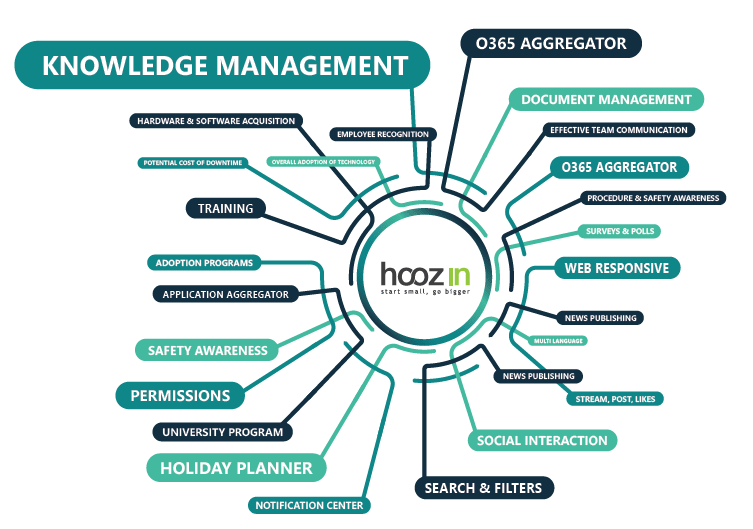
Knowledge Management is subject to change. Knowledge is slipping out of those un-agile containers called folders. In the world of Hoozin, we make a distinction between 2 types of Knowledge Management. These are primarily:
‘’Knowledge management (KM) is the process of creating, sharing, using and managing the knowledge and information of an organization. It refers to a multidisciplinary approach to achieving organizational objectives by making the best use of knowledge. … KM is an enabler of organizational learning.’’
‘’Digital asset management (DAM) is a business process for organizing, storing and retrieving rich media and managing digital rights and permissions. Rich media assets include photos, music, videos, animations, podcasts and other multimedia content.’’
Hoozin Knowledge Management (KM) and Digital Asset Management is one of the many use cases Hoozin fulfills.

The evolution of Knowledge Management
Knowledge Management is no longer compressed in big central document management systems. They have become viral in the sense it can be retrieved from multiple sources. The creation of knowledge can occur just as well during a train trip as it can in a board room. Same applies to the need to find knowledge. To understand the new character of knowledge we need to plot the knowledge types against how this knowledge was conceived. Sounds complicated? It isn’t.
Equally important; how it can be found back by search and filters. Also, it should be noted that Knowledge Management should be an integrated part of a greater Digital Strategy. It should connect to the new way of working such as communities, stream, web responsiveness, security and configurable compliance.
We make a clear distinction between the following context of knowledge:
STRUCTURED KNOWLEDGE
This type of knowledge is often static and not too much subject to change. This often comes in the form of documents that express rules, compliance or procedures. They can easily be found by the masses and often are seen as ‘mainstream’ documents that all employees have a need for. This can be fire drill procedures, holiday request forms, etc. These are often easy to find through the Hoozin Intranet using the Global Navigation, our Toolbox (link manager). But also through our video widget. This type of knowledge rarely changes and is often produced within a top down approach that does not allow much editing and versioning.
DEPARTMENT TOPIC KNOWLEDGE
Here we see knowledge stored per department and relevant only to those that work in that department. Knowledge here can be very agile. This type of knowledge also tends to be ‘large’ in terms of amount of folders and files as well in terms of number of versions. Hoozin has a very community centric approach for this. Department can create communities that are secured and make knowledge relevant to only those that really need it. Hoozin communities can be public, secured or even hidden.
AGILE OR PROJECT KNOWLEDGE
This knowledge is often the most agile and needs most modifications. Here we see that simple versioning of documents is not enough. We need to be able to have social conversations around that doc in a stream mode. This ‘Social Knowledge’ has become increasingly more important for the greater need of contextual information at the right moment. Hoozin connects the classical Document Management process with that much needed layer of social interaction.
Now we need to try to understand how knowledge is conceived and why the classical pattern on how it flows has entirely changed. At Hoozin we want to make all types of knowledge storable and searchable. So not just documents, also the nitty conversations in a stream are seen as knowledge and valuable intel for later. In general we see 3 types:
Social Knowledge
This type of knowledge is often found back in the stream of Departments and Agile context knowledge.
Documents
Here we refer to any Microsoft Document as well as PDF.
Anti-Documents
We refer here to Digital assets such as Autocad, video, etc.
All of Hoozin Digital Asset Management includes some critical user benefits such as:
- Deployment in Cloud or on premises. Your choice.
- Entirely web responsive.
- Asset categorization
- Asset Sharing
- Asset Sharing with external users
- Customizable branding
- Fully integrated with the Hoozin Intranet or Digital Workplace
- Extensive usage Reporting
- Both filter and search engine
- Strong security for users on document and folder level
- Document and folder tagging
- Versioning with draft mode
- Re-publish in the Hoozin stream to ‘advertise’ the document in the social stream
- Allow comments in stream mode around a document
Hoozin Knowledge Management goes beyond the usual filleter, search and tagging. We order Knowledge in communities, with clear security protocols. Beyond this, we consider conversations and comments also contributor to Knowledge Management.
Don’t forget to follow us on Twitter!
Carwin Heierman.




Leave a reply